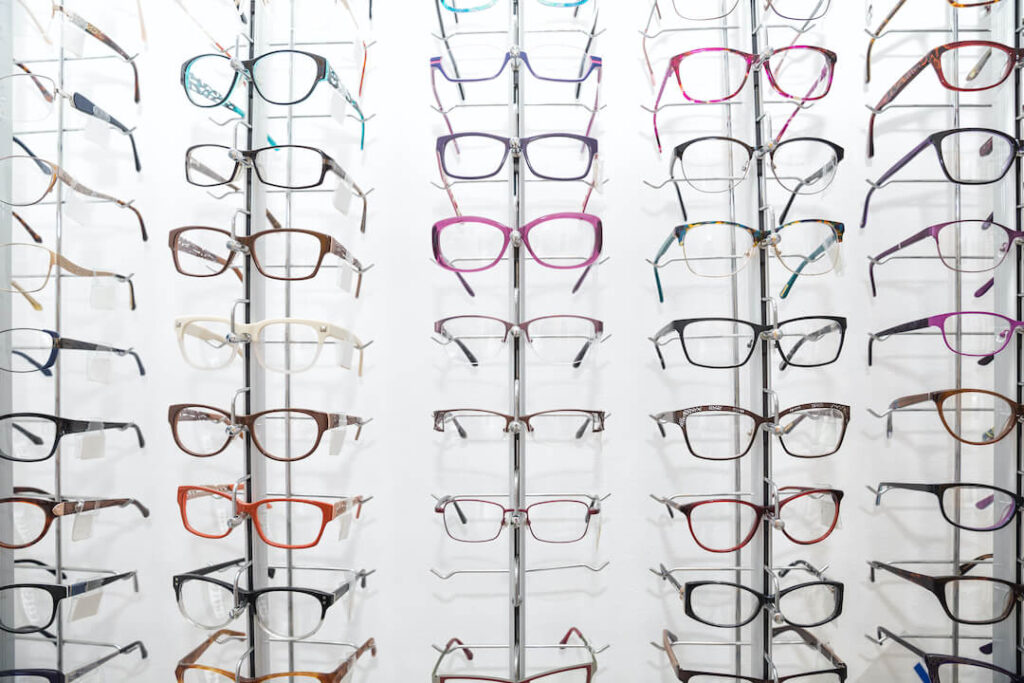Ever felt like you’re in a never-ending maze while exploring glasses options? It’s as if you’re navigating through an optical jungle, trying to decipher complex terms and make sense of different lens types. That feeling can be overwhelming.
Remember your first pair? You walked into the eye doctor’s office with blurry vision and left seeing the world in high-definition. A transformative moment indeed!
We all know glasses are not just about clear vision; they’ve become a style statement, too. But how do we balance function and fashion without getting lost?
We’re here to guide you through everything, from grasping the concept of single-vision or multifocal lenses and demystifying materials like polycarbonate or Trivex to understanding specialty lenses such as prism ones. Plus, we’ll give you a hand in picking out frames that complement your face shape perfectly! To help you save on glasses, explore coverage options from Linneo.
Table of Contents
Lens Types for Vision Correction
But with so many lens options available, where do you start?

Single-vision lenses are a common type of entire lens used in prescription glasses. They’re designed to correct one field of vision – either distance or near.
If you spend most of your day reading or working on a computer, single-vision lenses may be perfect because they offer the largest viewing area in that range. Learn more about these simple yet effective types of optical lenses.
The Power of Multifocal Lenses
Multifocal lenses bring multiple powers into a single lens – think bifocals or trifocals.
Bifocal lenses/trifocal options help correct presbyopia (age-related farsightedness) while addressing other refractive errors like myopia (nearsightedness). This makes them ideal if you need help seeing both far away and up close without needing two pairs of glasses.
Decoding Lens Materials
Let's decode plastic, polycarbonate, trivex, high-index plastic, and glass lenses
Plastic lenses are favored for their lightness and affordability. The most common type is CR-39. They offer clear vision but can be a bit bulky for strong prescriptions.
Polycarbonate lenses came into play as an alternative to CR-39. They’re lighter and more impact-resistant, making them ideal for kids or those with active lifestyles.
For people with stronger prescriptions who want thinner glass frames without compromising on vision clarity, high-index plastic is the answer. These are slimmer than regular plastics because they bend light more efficiently.
Moving onto glass lenses, once the king of all materials. Though they provide unmatched clarity when compared to other materials, they’ve fallen out of favor because of their weighty feel on the nose and fragility. But for those who don’t mind a little heft in exchange for crystal-clear vision, they’re still an option.
Remember, it’s not just about the material; your lens choice also depends on your lifestyle, prescription strength, and personal preferences. Whether you need glasses to read the fine print or play sports without squinting, there’s a perfect pair out there waiting for you.
Exploring Lens Coatings and Treatments
You might wonder why lens coatings matter when choosing glasses. Let's break it down

Lens treatments aren’t just a fancy add-on; they’re designed to enhance your vision and comfort and protect your eyes. For instance, a scratch-resistant coating is like an invisible shield for your lenses, making them more durable.
If you’ve ever been blinded by headlights at night or squinted at the glare off a shiny surface during the day, then anti-reflective coating could be your new best friend. This special treatment reduces glare and allows more light through the lens for clearer vision in various lighting conditions.
The Benefits of Anti-Reflective Coating
An anti-reflective (AR) coating, or an anti-glare lens surface treatment, eliminates reflections from eyeglass lenses that could obstruct clear sight lines. It’s particularly useful if you spend lots of time driving at night or staring at digital screens – but let’s face it: who doesn’t these days?
Beyond its practical benefits, AR coating has another plus point: it makes glasses look better. By reducing reflections off the front surface of glass lenses, people can see your eyes clearly behind them rather than seeing their own reflections bouncing back.
UV-blocking Treatment
We all know UV light can harm our skin over time outdoors, but did you realize this pesky form of radiation could also damage our eyes? That’s where UV-blocking treatments come into play.
UV-blocking treatments help to protect our eyes from the sun’s ultraviolet rays, reducing the risk of eye conditions like cataracts.
Blue Light Filtering
For those of us who can’t escape digital screens, blue light filtering is a real game changer. It blocks out harmful high-energy visible (HEV) blue light emitted by digital devices – reducing eye strain and potentially helping you sleep better at night too.
Indeed, many folks discover that this treatment significantly improves their comfort levels when using computers or tablets. It’s because it effectively eases some symptoms linked to Computer Vision Syndrome.
Understanding Specialty Lenses
These prescription lenses are not your typical prescription glasses—they have unique features that cater to specific needs
Sometimes our eyes don’t align perfectly, causing a condition known as strabismus or double vision. This is where prism lenses come in handy. They help redirect light onto the correct part of the retina, providing clear and single vision.
Here’s an informative guide detailing all the different glass parts, including how prisms correct misalignments.
Transition Lenses
If you spend lots of time outdoors and find switching between sunglasses and eyeglasses annoying, transition lenses could be a great option for you. These lenses adapt to changing light conditions – darkening under bright sunlight while staying clear indoors.
No need to squint when stepping outside on a sunny day. Your transition lenses are covered automatically and adapted to protect your eyes from harmful UV rays.
Tinted Lenses
Besides being fashionable accessories, tinted contact lenses offer functional benefits depending on color. For instance, yellow tints can increase contrast, making them useful for foggy or hazy conditions, while blue tints can reduce glare, particularly during snowy weather.
It’s fascinating how something as simple as adding color can enhance visual comfort.
Remember that choosing any lens should always involve consultation with an eye care professional who understands your medical history and lifestyle considerations.
With the right specialty lenses, you’re not just using distance vision or correcting your vision – you’re enhancing it.
Remember to always consult with an eye care professional when choosing any kind of lens. They can provide a comprehensive understanding of both your medical history and lifestyle considerations. With their help, you’ll be on track toward a clear and comfortable vision in no time.
Frame Selection Tips
If you're hunting for the perfect glasses, remember that frames matter as much as lenses.

Glass frames come in two main types: metal and plastic. Each has its pros and cons, which can affect your vision, comfort, and style preferences. For instance, metal frames are typically more durable than their plastic counterparts.
Plastic frames offer a wider range of colors and styles but might lack the longevity of metals like titanium or stainless steel. But hey. Don’t forget to consider how they feel on your face before making any decisions.
Selecting Frames That Suit Your Face Shape
A major factor when selecting frames is matching them with your face shape because, let’s be honest – we all want our glasses to flatter us. Here’s a guide to help you select suitable frame styles based on facial features.
Sometimes, sticking with classic shapes like rounds or rectangles may serve better for everyday wear while providing an elegant look.
For those who fancy walking on the wild side, though, there’s no harm in exploring new frontiers in eyeglass design.
Regardless of your route—trendsetter or timeless beauty—remember these tips should lead you toward finding your dream pair of glasses. Happy shopping.
The Cost of Eyeglass Lenses
The cost of eyeglass lenses can vary based on the type, materials, treatments, and style preferences chosen.
Lens types have a significant impact on the price. Single-vision lenses are generally cheaper than multifocal ones like bifocals or trifocals. Multifocal lenses, which correct for nearsightedness high index lenses and farsightedness in one pair, offer more vision correction options but come at a higher price point.
Treatments & Coatings Applied
Add-ons like scratch-resistant coating or anti-reflective treatment increase durability and comfort but add to your bill. Blue light filtering also helps reduce eye strain from digital screens; it’s worth considering if you spend much time staring at devices. Note: You might want to skip this feature on non-prescription glasses.
Fashion Preferences & Specialty Options
Last but not least are style choices, which affect both frames AND lenses. Do you fancy tinted or transition lenses? They’ll darken automatically when exposed to UV light, perfect for time outdoors. And let’s not forget about specialty lenses such as prisms, which correct vision, double vision, or alignment issues – they’ll also add to the total cost.
FAQs About Different Glasses Options
What options are available for glasses?
Glasses offer diverse types of lens types like single-vision, multifocal, and specialty lenses. They come in different materials, such as plastic, polycarbonate, or glass. Coatings can include anti-reflective, UV-blocking, and blue-light-filtering treatments.
What is the best option for glasses?
The “best” glasses depend on your personal vision needs, lifestyle, and preferences. Consider factors like lens type (single-vision or multifocal), material (plastic vs glass), coatings (UV-blocking or anti-reflective), and frame style.
What are the different classes of eyeglasses?
Eyeglasses fall into various categories based on function: prescription eyewear corrects refractive errors; reading glasses help with presbyopia; sunglasses protect from harmful sunlight; safety glasses and goggles provide eye protection during hazardous work conditions.
What are the new types of lenses for glasses?
Newer lens technologies include digital high-definition lenses offering sharper vision than traditional lenses. Transition light-responsive lenses that adapt to changing light conditions have also gained popularity lately.
You’ve learned about single-vision and multifocal lenses for vision correction. You’re familiar with lens materials like polycarbonate or Trivex, each offering unique benefits.
We explored lens coatings that can enhance comfort and clarity while reducing eye strain from blue light exposure. And let’s not forget those specialty lenses for specific needs!
You’re equipped with tips on selecting frames that balance function and fashion perfectly for your face shape. Plus, we’ve shed light on how different factors affect eyeglass cost. In order to get the best possible deal, explore coverage options in your state!

